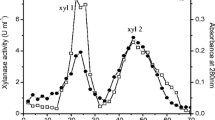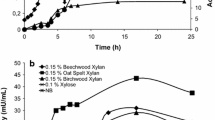Abstract
Some properties of purified endo-l,4-β-D-xylanase (1,4-β-D-xylan xylanohydrolase, EC 3.2.1.8) from the ligniperdous fungusTrametes hirsuta were investigated. The enzyme was stable between pH 4.0 and 8.0 with optimum activity at pH 5.0–5.5. The temperature optimum was 50 °C and the enzyme was stable for up to 30 min at 45 °C; however, it was denatured at higher temperatures. TheK m for 4-O-methylgluourono-D-xylan was 6.36. 10−3 equivalents ofD-xylose per litre, the activation energy was 28 kJ mol−1. The molecular weight determined by means of gel chromatography was 22000–24000. The enzyme was activated by Ca2+ and inhibited by Ag+ and Hg2+. On the basis of the effect of 2-hy-droxy-5 nitrobenzyl bromide, N-bromosuccimmide and N-aeetyhmidazole it may be assumed that trytophan and possibly tyrosine residues influence the enzyme catalysis.
Similar content being viewed by others
References
Andrevs P.: Estimation of the molecular weight of proteins by Sephadex gel-chromatography.Biochem. J. 91, 222 (1964).
Andrews P.: The gel filtration behaviour of proteins related to their molecular weights over a wide range.Biochem. J. 96, 595 (1965).
Boyer P. D.: Spectrophotometric study of the reaction of protein sulfhydryl groups with organic mercurials.J. Am. Chem. Soc. 76, 4331 (1954).
Buchler C. A., Kirchner F. K., Debel G. F.: 2-Hydroxy-5-nitrobenzyl-chlonde.Org. Synt. 20, 59 (1940).
Cohen J. A., Oosterbaan R. A., Berends F.: Organophosphorus compounds.Methods in Enzymology 11, 686 (1967).
Eriksson K. E., Pettersson B.: Purification and oharacterization of xylanase from the rot fungusStereum sanguinolentum.Int. Biodetn. Bull. 7, 115 (1971).
Gascoigne J. A., Gascoigne M. M.: The xylanase ofFusarium roseum.J. Gen. Microbiol. 22, 242 (1960).
Gundlach G. H., Stein W. H., Moore S.: The nature of the amino residues involved in the inactivation of ribonuclease by iodoacetate.J. Biol. Chem. 234, 1757 (1959).
Hashimoto S., Muramatsu T., Funatsu M.: Studies on xylanase fromTrichoderma viride. I. Isolation and properties of crystalline xylanase.Agr. Biol. Chem. 35, 501 (1971).
Horton H. R., Koshland D. E.: A highly colored reagent with selectivity for the tryptophan residue in proteins.J. Am. Chem. Soc. 87, 1126 (1965).
Hrazdina G., Neukom H.: Isolation of a xylanase from commercial cellulase preparation.Biochim. Biophys. Acta 128, 402 (1966)
Karácsonyi Š., Kubačková M., Hrivňák J.: The polysacchandes from white willow (Salix alba L.). The constitution of 4-O-methylglucurono-xylan.Collection Czech. Chem. Commun. 32, 3597 (1967).
King N. J., Fuller D. B.: The xylanase system ofConiophora cerebella.Biochem. J. 108, 571 (1968).
Kubačková M., Karácsonyi Š., Váradi J.: Studies on xylanase from Basidiomycetes. Selection of strains for the production of xylanase.Folia Microbiol. 20, 29 (1975).
Kubačková M., Karácsonyi Š., Toman R.: Purification of xylanase from wood-splitting fungusTrametes hirsuta (Wulf.) Pilát.Folia Microbiol. 21, 28 (1976).
Manners D. J., Wilson G.: Purification and properties of an endo-(l-3)-β-D-glucanase from malted barley.Carbohyd. Res. 37, 9 (1974).
Riordan J. F., Vallee B. L.: Reactions with N-ethylmaleimide and p-chloromercuribenzoate.Methods in Enzymol. 11, 545 (1967).
Riordan J. F., Wacker W. E. C., Vallee B. L.: N-Acetyhmidazole: A reagent for determination of “free” tyrosyl residues of proteinsBiochemistry 4, 1758 (1965).
Somogyi M.: Notes in sugar determination.J. Biol. Chem. 195, 19 (1952).
Sørensen H.: On the specificity and products of action of xylanase fromChaetomium globosum Kunze.Physiol. Plant. 5, 183 (1952).
Spande T. F., Witkop B.: Determination of the tryptophan content of proteins with N-bromosuocinimide.Methods Enzymol. 11, 498 (1967).
Váradi J., Nečesaný V., Kovács P.: Cellulase and xylanase of fungus Schizophyllum communo. III. Purification and properties of xylanase. (In Slovak)Drevársky výskum 3, 147 (1971).
Author information
Authors and Affiliations
Rights and permissions
About this article
Cite this article
Kubačková, M., Karácsonyi, S., Bilisics, L. et al. Some properties of an endo-l,4-β-D-xylanase from the ligniperdous fungusTrametes hirsuta . Folia Microbiol 23, 202–209 (1978). https://doi.org/10.1007/BF02876580
Received:
Issue Date:
DOI: https://doi.org/10.1007/BF02876580




